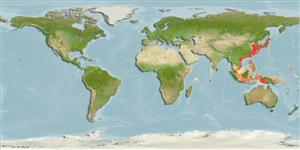Common names from other countries
Elasmobranchii (haaien en roggen) (sharks and rays) >
Carcharhiniformes (Ground sharks) >
Triakidae (Houndsharks) > Triakinae
Etymology: Mustelus: Latin for weasel, an ancient name for sharks, possibly referring to the pointed snouts, swift movements and/or rapacious feeding behavior of smaller predatory sharks [strictly not tautonymous with Squalus mustelus Linnaeus 1758 since type was designated by the ICZN]. (See ETYFish); manazo: Japanese vernacular for this shark. (See ETYFish).
More on author: Bleeker.
Environment: milieu / climate zone / depth range / distribution range
Ecologie
marien demersaal; diepte 0 - 360 m (Ref. 13563). Tropical; 45°N - 10°S
Western Indian Ocean: Kenya. Western Pacific: southern Siberia, Japan, Korea, China, Taiwan and Viet Nam; Chesterfield Islands (Ref. 11897).
Lengte bij maturiteit / Grootte / Gewicht / Leeftijd
Maturity: Lm 65.0, range 62 - 68 cm
Max length : 220 cm TL mannelijk / geslacht onbekend; (Ref. 4883); max. gepubliceerd gewicht: 5.7 kg (Ref. 40637); max. gerapporteerde leeftijd: 10 Jaren (Ref. 6081)
Found in the intertidal zone, on mud and sand bottom, down to a depth of at least 360 m (Ref. 13563). May also be found in semi-enclosed sea areas (Ref. 11230). Feeds mainly on bottom invertebrates, also bony fishes (Ref. 244). Ovoviviparous (Ref. 50449). Caught regularly by demersal longliners operating both inshore and in deep-water (Ref.58048). Utilized for human consumption (Ref. 244).
Ovoviviparous, embryos feed solely on yolk (Ref. 50449), with 1 to 22 (Ref.58048 reports 5-14)young in a litter. Gestation period takes about 10 months (Ref. 244) or 11-12 months (Ref. 28055). Young born in spring. Distinct pairing with embrace (Ref. 205).
Compagno, L.J.V., 1984. FAO Species Catalogue. Vol. 4. Sharks of the world. An annotated and illustrated catalogue of shark species known to date. Part 2 - Carcharhiniformes. FAO Fish. Synop. 125(4/2):251-655. Rome: FAO. (Ref. 244)
Status op de Rode Lijst van het IUCN (Ref. 130435)
CITES (Ref. 128078)
Not Evaluated
Gevaar voor de mens
Harmless
Gebruik door de mens
Visserij: commercieel; sportvis: ja
Tools
Speciale rapporten
Download XML
Internetbronnen
Estimates based on models
Preferred temperature (Ref.
115969): 14.4 - 28.1, mean 23.2 (based on 677 cells).
Fylogenetische diversiteitsindex (Ref.
82804): PD
50 = 0.5000 [Uniqueness, from 0.5 = low to 2.0 = high].
Bayesian length-weight: a=0.00214 (0.00117 - 0.00391), b=3.13 (2.97 - 3.29), in cm Total Length, based on LWR estimates for this species & Genus-body shape (Ref.
93245).
Trofisch niveau (Ref.
69278): 3.7 ±0.1 se; based on diet studies.
Weerstandsvermogen (Ref.
120179): Zeer laag, minimale populatieverdubbelingstijd meer dan 14 jaar (K=0.07; tm=1.9-4; tmax=10; Fec=1).
Fishing Vulnerability (Ref.
59153): High vulnerability (63 of 100).
